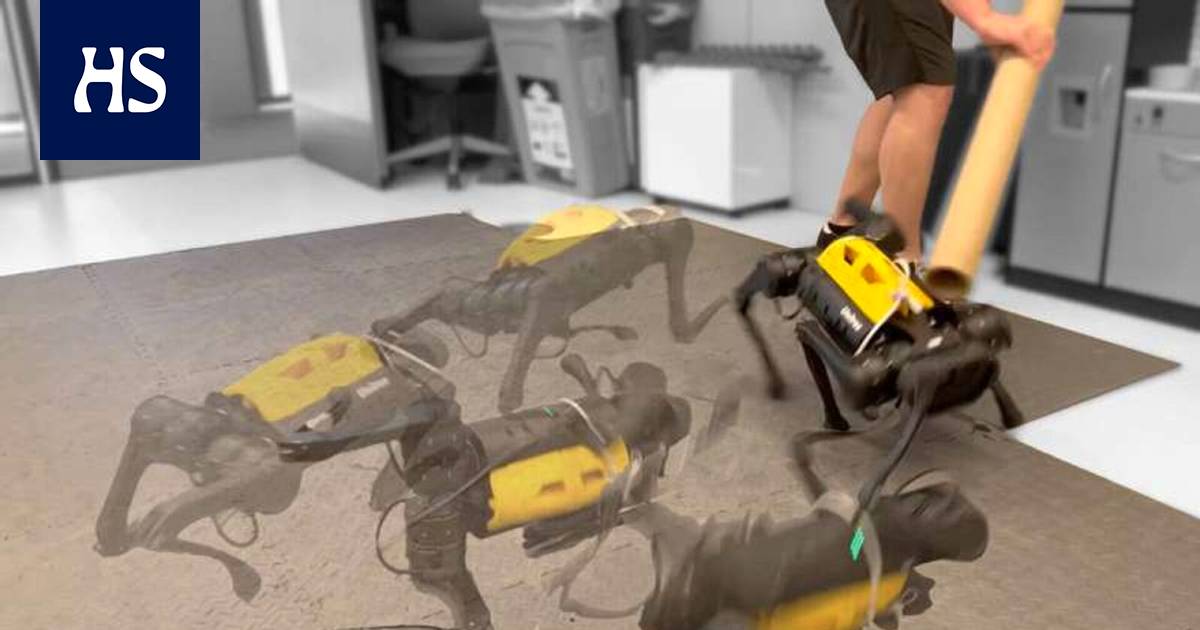The robot gets up and eventually moves forward with learning neural networks. Other robots were taught spatial awareness. The researcher believes that the robot will be self-aware already in 20–30 years.
Two both of them learned to walk a four-legged robot developed in different places quickly, in about an hour.
If you compare them to mammals, it also takes about an hour for a small foal to learn the same after birth.
Another quadruped has been developed at the University of California, Berkeley.
On video
and in the photos, a yellow robot the size of a medium-sized dog is initially swaying on its back. At some point, it accidentally turns so that the robot’s feet touch the floor below.
Then the learning starts to get there quickly. After about an hour, the robot can already walk with all its legs.
Robots researchers developed an open program for learning robots, which has received named DayDreamer. With it, the “robot dog” learns to walk. Learning neural networks help.
When the robot could already walk, the researchers subjected it to mild violence. Robot developers pushed it or fought to overturn it.
The robot wasn’t even bothered by the pushing, but got to its feet quite quickly and continued walking.
“
As more and more experiences come, the robot already learns to predict what might come up.
Robots training for the real world can take a lot of time. Now developed learning robots can save the time spent on testing.
They can also completely eliminate the use of different teaching devices and simulators. This also saves time and effort.
While walking, the robot receives confirmation from its surroundings all the time with its sensors. In this way, it also learns to adapt to environmental changes.
The robot interacts with the real world. It adds information to the memory where all previous experiences are stored. As more and more experiences come, the robot already learns to predict what might come up.
WHEN the robot can predict, it reduces training, says one of the researchers who developed the robot ie Danijar Hafner website for TechXplore.
Researchers are now teaching a robot to pick up objects. Its vision sensors also know how to adapt to changes in lighting. Even the shadows do not surprise its movement.
Hafner says the robot can also adapt to the fact that equipment can break. The robot walks even with a limp, even though one of the leg motors is broken.
The background work of the learning robot was presented to other researchers in the arXiv online service as a pre-release. The researchers’ work has not yet been peer-reviewed.
Second a robot in Germany, named Morti, has also learned to walk in a class. Morti, who looks a bit different, taught his limbs to walk by himself, says New Scientist.
At first, Morti also fell and fumbled, but after about an hour the artificial intelligence finds the right rhythm, says the developer of the robot Felix Ruppert. He is a researcher of intelligent systems at the Max Planck Institute in Stuttgart.
Mortia was guided to walk by an algorithm that didn’t know much about the robot dog’s legs. For example, it didn’t know what shape the legs had.
“
Artificial intelligence mimics the networks of neural networks that some animals have in their spinal cords.
The Germans the artificial intelligence used imitates the kind of networks formed by neural networks that some animals have in their spinal cords.
They control the animal’s gait and make the muscles contract in the right rhythm.
Morti learned to reduce his energy consumption when he learned to walk better.
It reduced its energy consumption by almost half, says New Scientist. The science magazine also reported on the robot Nature Machine Intelligence.
For others robots have begun to be taught self-awareness with ancient wisdom – know yourself. Or rather: describe yourself.
Robots are usually trained to rely on sensors to “sense” when they are designed to do a task. However, they have no understanding of why they are performing a task.
Robots don’t even know what physical state they are in.
“People consider this sense of space to be survival,” says the robot researcher Boyuan Chen from Duke University in North Carolina.
“I’ve tried to make machines understand what they are, and not just assemble objects. They also have to think about themselves”, says the second author of the study, Hod Lipson from Columbia University in New York.
So Lipson and Chen put a robot with arms in a lab where it was surrounded by five cameras. They depicted a robot.
“
“I believe that a robot will be self-aware in the human sense in about 20-30 years.”
Cameras fed video images back to the neural network that was part of the robot and its program. The neural network followed the robot’s movements in this state.
The robot’s neural network received three hours of data on the mechanical movement of the arm. It produced 7,888 data points from the environment.
The researchers then tested whether the robot had learned to predict the position of the robot arm in space.
It found its place with an accuracy of one percent. So if the workspace were a meter in size, this robot would estimate its position with an accuracy of a centimeter.
Researchers consider the neural network as part of the robot itself. Now the robot has the permanent ability to find out where it physically is at any time.
This is the first time in the history of robotics that a robot has been able to create a model by photographing itself, says Lipson.
According to Lipson, this is a step towards robot self-awareness. However, in everyday work, this robot would always have to learn the new environment in which it works in the same way.
“I think a robot will be self-aware in the human sense in about 20-30 years,” he says according to New Scientist.
The study was published by science magazine Science Robotics.
#Robotics #robots #learned #walk #class #photographed #researcher #robot #step #selfawareness









